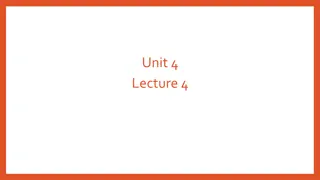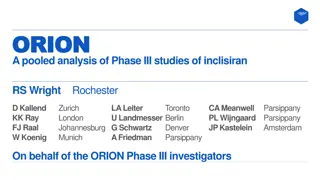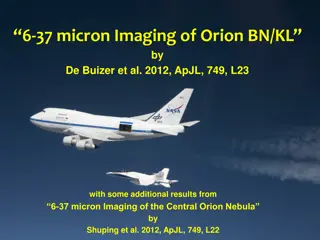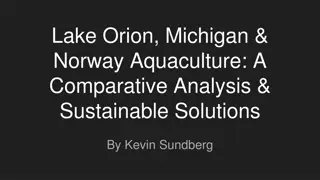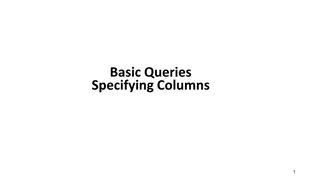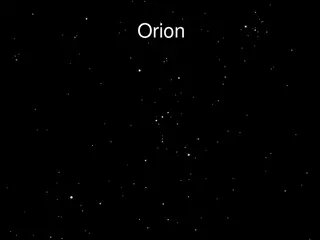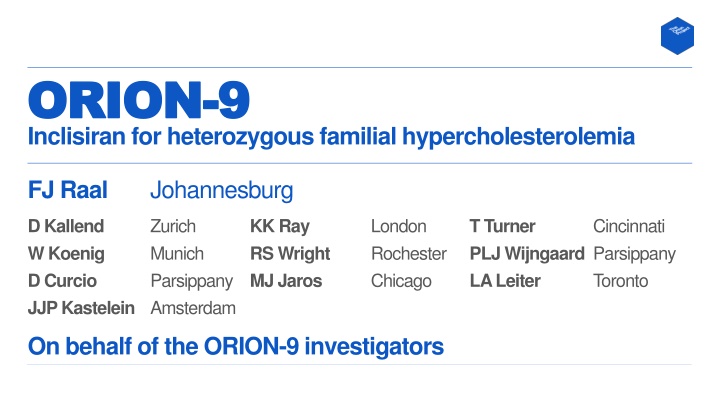
ORION-9 Inclisiran for Heterozygous Familial Hypercholesterolemia: Background and Rationale
Learn about the ORION-9 study focusing on Inclisiran for treating heterozygous familial hypercholesterolemia. The research delves into the prevalence and challenges of this genetic disorder, emphasizing the importance of LDL-C lowering therapy. Discover the potential of Inclisiran, a small interfering RNA, through phase I-II studies and dose-finding analyses. Acknowledgements and contributions from multiple sites across countries add depth to this crucial research.
Download Presentation

Please find below an Image/Link to download the presentation.
The content on the website is provided AS IS for your information and personal use only. It may not be sold, licensed, or shared on other websites without obtaining consent from the author. If you encounter any issues during the download, it is possible that the publisher has removed the file from their server.
You are allowed to download the files provided on this website for personal or commercial use, subject to the condition that they are used lawfully. All files are the property of their respective owners.
The content on the website is provided AS IS for your information and personal use only. It may not be sold, licensed, or shared on other websites without obtaining consent from the author.
E N D
Presentation Transcript
ORION ORION- -9 9 Inclisiran for heterozygous familial hypercholesterolemia Johannesburg FJ Raal Zurich Munich Parsippany London Rochester Chicago Cincinnati D Kallend W Koenig D Curcio JJP Kastelein Amsterdam KK Ray RS Wright MJ Jaros T Turner PLJ Wijngaard Parsippany LA Leiter Toronto On behalf of the ORION-9 investigators
ORION-9: Acknowledgements Contributions from 46 sites in 8 countries Lead enrolling investigators Canada Czech Republic Denmark Netherlands Jean Bergeron Daniel Gaudet Victor Adamkova Lucie Solcova Erik Schmidt Ib Christian Clausen Frank Visseren Erik Stroes Elaine van Nieuwenhuizen Nyda Fourie Jose Luis Diaz Diaz Xavier Pinto Sala Iftikhar Ebrahim Soritza Coetzer South Africa Spain Daniel Zambon Rados Sweden United States Mats Eriksson Stefano Romeo Traci Turner John Homan 2
ORION-9: Background and rationale HeFH highly prevalent and clinically challenging A genetic disorder affecting 1 in 250 or ~30 million people worldwide1 Life-long cumulative exposure to highly elevated LDL-C, starting at birth Drives early onset, accelerated atherosclerotic cardiovascular disease Over 90% not identified or properly diagnosed LDL receptor gene mutations account for >90% cases2 APOB (5%) and PCSK9 (<2%) mutations account for most other cases Monogenic mutation not identified in up to 30% of subjects with a clinical diagnosis3 Management is primary prevention of ASCVD through LDL-C lowering therapy4 High intensity statins ezetimibe monoclonal antibodies against PCSK9 1. Nordestgaard et al. Eur Heart J 2013;34:3478-3490. 2. Berberich and Hegele. Nat Rev Cardiol 2019;16:9-20 3. Talmud et al. Lancet 2013381:1293-301 4. 5. 6. Defesche et al. Nature Reviews 2017;3:17093 doi:10.1038/nrdp.2017.93 Raal et al. Lancet 2015;385:331-340 Kastelein et al. J Clin Lipidol 2017;11:195-203 3
ORION-9: Background and rationale Phase I-II studies identified twice-yearly dose potential Inclisiran is a small interfering double- stranded RNA1 Selected data from ORION-1 dose finding study Harnesses natural process of RNAi in liver placebo Dose-finding2 and PD modeling3 showed durable, potent effects on LDL-C 100 mg 200 mg 300 mg 300 mg led to 53% lowering of LDL-C Extension studies affirmed long-term effect 1. 2. 3. Fitzgerald et al. N Engl J Med. 2016;376:41-51 Ray et al. N Engl J Med 2017; 376: 1430-40 Kastelein personal communication at NLA Annual Meeting, Miami, May 2019 4
ORION-9: Objectives Efficacy and safety over 18 months in subjects with HeFH Study endpoints 1. Effectiveness Primary Percent LDL-C change vs. placebo At day 510 Average over days 90 540 Secondary LDL-C change over time Changes in PCSK9 and other lipids 2. Safety and tolerability Treatment emergent adverse events Laboratory parameters 3. Exploratory Treatment response by FH genotype 5
ORION-9: Patient entry criteria Heterozygous FH diagnosed by genotype or phenotype Inclusion criteria Exclusion criteria Age 18 years Prior (90d) or planned use of PCSK9 mAbs MACE within 3 months of randomization NYHA class III-IV HF or LVEF 30% Uncontrolled severe hypertension Severe concomitant non CV disease Fasting TG >400 mg/mL (4.52 mmol/L) Pregnant, nursing or without contraception HeFH diagnosed by genetic testing and/or Simon Broome criteria1 LDL-C 100 mg/dL (2.6 mmol/L) Stable on a low-fat diet Maximally tolerated statin doses Ezetimibe allowed Informed consent 1. BMJ. 1991; 303: 893 896. 6
ORION-9: Study design Eighteen months treatment and observation Randomized 1:1 inclisiran 300 mg vs. placebo with maximally tolerated statins Visit 1 Day 1 V2 V3 V4 V5 V6 V7 V8 End of Study Day 540 (V9) 90 days post last dose Day 30 Day 90 Day 150 Day 270 Day 330 Day 450 Day 510 Screening Day -14 to -1 Study assessments 7
ORION-9: Genotyping Methods of genotyping met current standards For subjects who consented to participate in the genetic sub-analysis Next generation sequencing performed Coding regions of LDLR (exons 1-18), APOB (1-29), PCSK9 (1-12), LDLRAP1 (1-9) Pair-end DNA sequencing on the Illumina MiSeq sequencing platform 2o and 3o analysis with commercial bioinformatics software Variants aligned to GRCh37/hg19 reference genome; classified by current guidelines1,2 LDLR variants grouped Pathogenic Likely pathogenic Uncertain significance 1. Richards S, et al. Genet Med 2015;17(5):405-24. 2. Chora et al. Genet Med 2018;20:591-598. doi: 10.1038/gim.2017.151 8
ORION-9: Statistical plan Sample size sufficient and alpha spending controlled Sample size assumptions required 400 eligible patients Mean LDL-C reduction will be no less than 30 mg/dL (SD 20 mg/dL) with 5% drop outs >90% power to detect 30% lowering of LDL-C level with one-sided = 0.025 Alpha spending controlled for co-primary and secondary efficacy endpoints Family-wise type I error rate controlled using a sequential testing procedure Hochberg procedure applied for secondary endpoints Pre-specified imputation methods used to account for missing data Pre-specified sub-group analyses by FH genotype 9
ORION-9: Patient disposition High proportion of patients completed 18 month study Abbreviated consort diagram Other Withdrew consent Died 5 4 1 ITT Safety1 240 240 Completed 96% Placebo Screened 617 Randomized 482 ITT Safety1 241 242 Screen failures Entry criteria miss Withdrew consent Other 135 122 12 Completed 97% Inclisiran 1 Died Medication not given Other 1 1 5 1. Safety population comprises any subject given any study medication 10
ORION-9: Patients High-risk phenotypes balanced by randomization Patient characteristic ITT population1 Age median (IQR) years Male gender Placebo N = 240 56 (47, 63) 115 (48%) Inclisiran N = 242 56 (46, 64) 112 (46%) Atherosclerotic cardiovascular disease Lipid management treatment Statins Of which high intensity statins given Ezetimibe use Baseline LDL-C mg/dL 73 (30%) 59 (24%) 217 (90%) 171 (79%) 135 (56%) 155 (58) 219 (91%) 185 (84%) 120 (50%) 151 (50) ( SD)2 1. All patients who were randomized, analyzed according to randomization 2. SD is standard deviation 11
ORION-9: Patients Genotyping results for 432 patients giving consent Genetic variants ITT population1 Genetic testing performed LDLR variants Of which Two variants ( double ) APOB variants PCSK9 gain of function variant No variant detected Placebo N = 240 211 131 (55%) 118 (90%) 9 (7%) 4 (3%) 15 (6%) 11 (5%) 0 54 (23%) Inclisiran N = 242 221 125 (52%) 113 (90%) 8 (6%) 4 (3%) 22 (9%) 12 (5%) 1 (0.4%) 61 (25%) Pathogenic Likely pathogenic Uncertain significance 1. All patients who were randomized, analyzed according to randomization 12
ORION-9 Efficacy results Efficacy results
ORION-9: Efficacy Highly significant lowering of LDL-C relative to placebo Treatment group N (ITT) Percent change LDL-C Mean at day 510 Observed Imputed1 Time-averaged day 90 - 540 Observed Imputed2 240 + 8 + 8 + 6 + 6 Placebo 242 - 41 - 40 - 39 - 38 Inclisiran Difference (1o endpoint) - 50% - 48% - 45% - 44% P-value <0.0001 <0.0001 1. A wash-out model was used to account for missing data 2. A pattern mixed model was used to account for missing data 14
ORION-9: Efficacy Durable and potent effect over 18 months Percent change in LDL-C over time observed values in ITT patients 20 % LDL-C ( 95% CI) 0 50% 70.6 mg/dL Time-averaged 45% -20 -40 -60 0 3 6 9 12 15 18 Months from start of treatment P-value for placebo inclisiran comparison at each time point <0.001 1. All 95% confidence intervals are less than 2% and therefore are not visible outside data points 15
ORION-9: Efficacy Change in LDL-C by genetic variants 50 Inclisiran Placebo Legend and number of patients % LDL-C (95% CI) 0 LDLR variants Two variants APOB PCSK9 gain of function None identified 131 15 11 125 22 12 -50 0 1 54 61 -100 0 3 6 9 12 15 18 Months from start of treatment 16
ORION-9 Safety results Safety results
ORION-9: Safety and tolerability Safety profile similar to placebo except AEs at injection site Treatment emergent adverse event (TEAE) Safety population1 AEs in 5% patients Placebo N = 240 Inclisiran N = 241 Patients with at least one TEAE Nasopharyngitis Influenza Upper respiratory tract infection Back pain Injection site reaction Gastroenteritis 172 (72%) 20 21 16 10 0 6 185 (77%) 28 (12%) 13 16 17 22 11 (8%) (9%) (7%) (4%) (5%) (7%) (7%) (9%) (5%) (3%) 1. Safety population includes all patients who received at least 1 dose of study medication 2. Other TEAEs reported with lower frequencies than 5% in any group had no clinically meaningful differences 18
ORION-9: Safety and tolerability AEs at injection site mostly mild and all transient TEAEs at injection site Safety population1 Placebo N = 240 Inclisiran N = 241 Protocol-defined event 1 (0.4%) 33 (13.7%) 13.3% (Reaction, erythema, rash, pruritus, hypersensitivity) Mild 1 (0.4%) 29 (12.0%) 11.6% Moderate 0 (0.0%) 4 (1.7%) 1.7% Severe 0 (0.0%) 0 (0.0%) Persistent 0 (0.0%) 0 (0.0%) 1. Safety population includes all patients who received at least 1 dose of study medication 19
ORION-9: Safety and tolerability No evidence of liver, kidney, muscle or platelet toxicity Laboratory tests Safety population1,2 Placebo N = 240 Inclisiran N = 241 Liver function 1 1 0 3 1 5 1 (0.4%) (0.4%) 3 2 2 4 1 4 0 (1.2%) (0.8%) (0.8%) (1.7%) (0.4%) (1.7%) ALT >3x ULN AST >3x ULN ALP >2x ULN (1.2%) (0.4%) (2.1%) (0.4%) Bilirubin >2x ULN3 Kidney function Muscle Hematology Creatinine >2 mg/dL CK >5x ULN Platelet count <75x109/L 1. Safety population includes all patients who received at least 1 dose of study medication 2. Patients may be counted in more than one category 3. No cases met Hy s Law 20
ORION-9: Safety and tolerability No difference in serious adverse events Serious TEAEs Safety population1,2 Placebo N = 240 Inclisiran N = 241 Patients with at least one serious TEAE All cause death Cardiovascular 33 (13.8%) 1 (0.4%) 0 0 3 (1.2%) 18 1 1 0 2 (7.5%) (0.4%) (0.4%) Cancer (0.8%) New, worsening or recurrent malignancy Pre-specified exploratory CV endpoint3 10 (4.2%) 10 (4.2%) 1. Safety population includes all patients who received at least 1 dose of study medication 2. Patients may be counted in more than one category 3. MedDRA-defined CV basket of non-adjudicated terms cardiac death, and any signs or symptoms of cardiac arrest, non-fatal MI and/or stroke 21
ORION-9: Summary and conclusions Inclisiran lowered LDL-C by up to 50% safely in HeFH Well-powered 18 month double-blind randomized placebo controlled HeFH trial ORION-9 met all primary and secondary efficacy endpoints 50% (70.6 mg/dL) observed LDL-C lowering at day 510 45% time-adjusted LDL-C lowering day 90-540 On top of statins (>90%) and ezetimibe (>50%) Reduction in LDL-C independent of underlying FH genotype Safety profile of inclisiran was similar to placebo in a high-risk population Adverse event incidence and laboratory values not different Injection site events were ~13% higher on inclisiran mostly mild and all transient Inclisiran shows potential to address the unmet need of high risk HeFH patients 22


